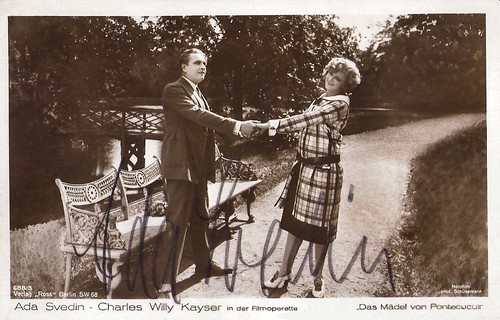
Dutch postcard. Photo: publicity still for Die blonde Geisha/The blonde Geisha (Ludwig Czerny, 1923).
Spotted By Chance
Ada Svedin was born in Hohensalza, Germany (now Inowrocław, Poland) in 1894 (according to IMDb in Berlin in 1900). Her father was a composer and musician.
Ada started her career as a secretary at the Deutsche Bank in Brussels, Belgium.
When she came to Berlin, film director Ludwig Czerny spotted her by chance. He engaged her for his films in which she from early on impersonated leading roles.
Among her first films were Er geniesst/He enjoys (1918), Die geborgte Villa/The borrowed villa (1918), Die Notbremse/The emergency brake (1918) and Wie die Grossen/As the great (1918), made for the production company of Oskar Einstein.
In 1919 Czerny engaged her for the female lead role in his Melodie des Herzens/Melody of the Heart (Willi Achsel, Ludwig Czerny, 1919) opposite Charles Willy Kayser.
That year, she also appeared with Kayser in Das Nachttelegramm/The night Telegram (Ludwig Czerny, 1919). She also had a part in Das Caviar-Mäuschen/The Little Caviar Mouse (Gerhard Dammann, 1919).

German postcard by Ross Verlag, no. 944/2, 1925-1926. Photo: Noto-Film / Schünemann.

German postcard by Ross Verlag, no. 944/1, 1925-1926. Photo: Noto-Film / Schünemann.
The Czerny-Springefeld Method
Ada Svedin and her director married in 1919. Czerny founded the production company Noto-Film Gmbh and in the coming years, he directed and produced several silent film operettas starring his wife.
German Wikipedia: “Czerny had co-developed an invention (the so-called Czerny-Springefeld method) which copied a score sheet into the film negative. Thus the conductor and his orchestra could use this as a template for the cinematic musical passages; and singers in the cinema sang in sync with the lip movements the arias of the actors on the screen”
Svedin then played a countess in Das Kussverbot/The kiss ban (Ludwig Czerny, 1920).
In her next film Miss Venus (Ludwig Czerny, 1921), Charles Willy Kayser was her co-star again. Sunny boy Willy Fritsch made his film debut in a supporting part in this silent film operetta.
In Jenseits des Stromes/Beyond the stream (Ludwig Czerny, 1922), Svedin co-starred with Walter Janssen, but in Die blonde Geisha/The blonde Geisha (Ludwig Czerny, 1923), Kayser was her film partner once again.
In spite of the considerable effort of Czerny, Svedin and their Noto-Film, these films proved to be technically imperfect and also quite unsuccessful.
Svedin’s final silent operetta was Das Mädel von Pontecuculi/The Girl from Pontecuculi (Ludwig Czerny, 1924), again with Charles Willy Kayser as her co-star.
After this production Svedin retired from the film business. Noto-Film made one more film and then also stopped. Czerny produced some short documentaries during the 1930s.
Ada Svedin died in 1975 in her homeplace Berlin.

German postcard by Ross Verlag, no. 688/5, 1919-1924. Photo: Noto-Film / Schünemann. Publicity still for the silent operetta film Das Mädel von Pontecuculi/The Girl from Pontecuculi (Ludwig Czerny, 1924).
Sources: Thomas Staedeli (Cyranos), KinoTV.com, Fimportal.de, Wikipedia (German) and IMDb.
No comments:
Post a Comment